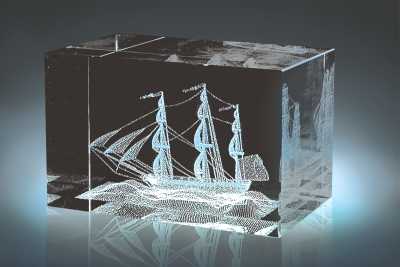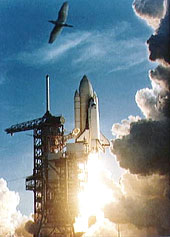NASA wastes money on worthless projects
Russian government deprives the inventors of bread and butter while NASA invests into rot
Laser graphic art souvenirs are very popular with tourists all over the world. State-of-the-art 3-D laser images created in optical quality crystals, combining artistry with technology. Laser beam creates this art of light, between  3D painting and sculpture. Powerful laser beam is highly focused on a spot inside crystal, melting microscopic piece of glass. Then system refocuses to burn another spot, corresponding with the previous one. It is repeated thousands of times, to create this amazing 3-D image inside the glass. The one who holds the patent for such crystals must be getting a lot of money. The technology was developed by a Russian but patented by crafty foreigners. And they are the ones who get the tasty morsel.
3D painting and sculpture. Powerful laser beam is highly focused on a spot inside crystal, melting microscopic piece of glass. Then system refocuses to burn another spot, corresponding with the previous one. It is repeated thousands of times, to create this amazing 3-D image inside the glass. The one who holds the patent for such crystals must be getting a lot of money. The technology was developed by a Russian but patented by crafty foreigners. And they are the ones who get the tasty morsel.
Extracting information and then assuming the rights for invention is as easy as it gets. It turns out that foreigners are those who are the most interested in Russian inventions. They realize the need for implementing know-how and they have means to do it. However, they are not eager to pay Russians. There is no need to do it if you can get everything for free. Foreigners say: “We would like to buy your invention but before you patent it in Russia we want to make sure it is viable. Answer several questions before we set up a deal”. All of the following questions shoot in the eye. After simple-minded inventor answers the last question the patrons disappear and using the information they obtained seal a patent.
There is another way of cheating on inventors. In the Soviet period the state was buying the inventions while nowadays the inventor must pay a significant state duty for filing an application, its examination and a patent itself. Moreover, a man of genius who remains without recognition must pay yearly duty on patent. Inventor must pay 300 rubles ($10,5) of yearly duty plus extra 200 rubles ($7) for a so-called patent's support. The sum seems not so large at the first glance but what if the inventor holds 50 or 80 patents at the same time, which is common? In this case it is a round sum that increases every year.
 Businessmen wait quietly until inventor is unable to support his patent. Usually inventor supports the patent for two or three years hoping to sell it and then gives up this idea.
Businessmen wait quietly until inventor is unable to support his patent. Usually inventor supports the patent for two or three years hoping to sell it and then gives up this idea.
As a result, to support modern Edisons Russian government does its best to deprive them of motivation for creating anything else and to leave them without bread and butter.
There is a popular myth that says that Soviet government fondled inventors and paid them money. They say that in USSR 312 thousand inventions were patented during the tenth five-year plan or Piatiletka, one of the nation-wide centralized exercises in rapid economic development. The number of patents that are sealed in today's Russia varies between 20 and 23 thousand every year. As a result, the number of patents that are registered yearly is thrice (!) less than it used to be.
Sounds impressive. But this is just a half-truth. If we take a look back at the end of the 1970s, which were the time of stagnation, we will see that the number of patents was considered the main factor in evaluation of scientific research institutes' performance.
To reach the necessary number scientists tumbled to an idea that it is profitable to divide one invention into several patent applications. Inventors received limp-sum payment of 20-200 rubles ($30-300) for each invention, but one inventor could not receive more than 50 rubles ($74).
That is why the official statistics of 1980 says that the averagenumber of people registered under one invention was three and a half. It is these three and a half people that received their 200 rubles ($300) with a maximum of 50 rubles ($74) for each inventor.
Russia is used to solve its problems with the orientation on the West, the US especially. However, on closer view it turns out that it is not so perfect overseas, as it seems.
NASA has a budget of billions of dollars at its disposal. NASA has a so-called Institute for Advanced Concepts (NIAC). “NIAC seeks proposals for revolutionary aeronautics and space concepts that could dramatically impact how NASA develops and conducts its missions”, according to its website. This means that the Institute is supposed to implement scientists' proposals in the sphere of space exploration.
However, according to Dr. Alexander Bolonkin, who worked for NASA for more than six years, NIAC is a virtual organization consisting of Mr. Cassanova as its CEO and his assistant. In spite of NIAC's pretensions to openness Cassanova refuses to answer any questions concerning organization's activity.
Bolonkin also said there was inappropriate attitude towards new inventions. Inventors, for instance, must solve all of the problems concerning their invention, which is impossible at the stage of filing the application.
“NASA paid for the 113 projects during six years of NIAC's existence. Total expenses were estimated at more than $20 million plus 30 percent to Mr. Cassanova”, Bolonkin said. These projects were found worthless by the scientific society. At the same time projects that could really reduce the expenses on space exploration cannot be materialized.
One of such examples is space elevator without using space rockets or space flights – Earth-Moon transportation system that will be able to transport thousands of tones of freight every year at the price of one or two dollars for a pound. This method allows using any celestial body (asteroids or meteorites, for instance) to change speed and trajectory of spacecrafts without wasting the fuel. This enhances the spacecraft's potential millions of times.
It turns out that corruption is flourishing in the prosperous US as well. When it comes to Russia, it remains unclear how to change the situation with inventors. It is obvious that implementation of new technologies can bring good profit, but only when the company do not spare itself on implementing know-how.
Siemens, for instance, provides large sums for encouraging inventors, scientists and its own R&D. Last year it invested about 5,1 million euros into scientific research. The personnel of the company’s research centers include almost 45000 people. Company's generosity pays for itself. The turnover of the German company was estimated at about 72 million euros last fiscal year. 75 percent of this profit is gained thanks to the products and services developed during recent five years!
Siemens holds more than 48000 patents. In fact, many of the company’s projects led to true technological revolutions. In 1956, for instance, Siemens engineers found a method of producing high-purity silicon. This innovation was a key to invention of microprocessors, electronic memory cards and federated schemes. Today microelectronics would not be possible without this invention. To lift Russian science the interest of businessmen is needed. This refers to large enterprises, in the first place. This should be government's concern. However, at the moment its absurd patent laws and inertia only put obstacles in the way of country's development.
Igor Parfinenko
Subscribe to Pravda.Ru Telegram channel, Facebook, RSS!





